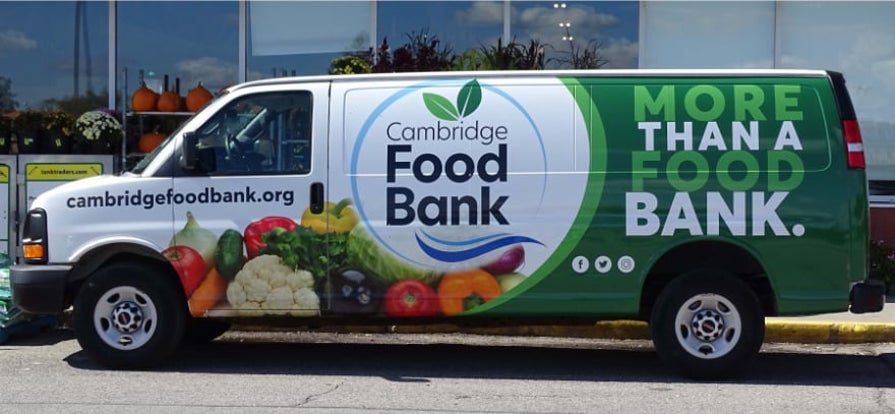How the Cambridge Food Bank is leading the way in food recovery with help from Conestoga

Nicole Detlor and Cynthia Riddle, Conestoga Food Research & Innovation Lab, Stephen Thomson, School of Business
For nearly 40 years, the Cambridge Food Bank has expanded its services to better support the community through programs such as emergency food hampers and the mobile food market.
As food bank usage in Canada reaches all-time highs, the Cambridge Food Bank is seeing the impact close to home. One out of every eight people in the City of Cambridge and North Dumfries relies on its services.
To continue meeting growing demand, the Cambridge Food Bank partnered with Conestoga to improve its food recovery efforts, ensuring it could offer as much high-quality food as possible.
Amy Slack, director of operations at the Cambridge Food Bank, had previous experience working with the college and knew she could count on Conestoga’s researchers and faculty for support.
“I had worked with someone at the college previously and knew the college could help us better capture our food recovery processes,” Slack said.
When food arrives at the food bank, staff account for it and sort it into different programs based on type and quality. For example, overripe but still edible food goes into the Flash Food program, where clients have unlimited access and food must be eaten the same day.
But what happens to the food that doesn’t make it to the plates of people in the City of Cambridge and North Dumfries region?
That’s where Nicole Detlor, director of the Conestoga Food Research & Innovation Lab (CFRIL), and Stephen Thomson, a professor in Conestoga’s School of Business, stepped in.
The researchers began by conducting a food waste audit to pinpoint where waste occurred inside the food bank. Although the food bank already prioritized diversion and recovery, Detlor and Thomson looked for areas where waste wasn’t being captured or redirected into a new stream.
“We quickly learned just how fast food comes into the food bank,” Thomson said. “It was hard to keep track of it all and analyze it.”
By evaluating the flow of food at both the micro and macro levels, the research team discovered unexpected results.
“We were surprised to learn that the current process didn’t generate any waste,” said Thomson. “They were utilizing nearly every bit of food that arrived at the food bank.”
As a result, the research team shifted focus to understanding how the Cambridge Food Bank operates efficiently.
“We wanted to flip this result into a way to leverage new funding, and engage new volunteers and projects,” said Detlor.
Slack quickly got on board with the new direction of the project.
“By translating these results, we are able to demonstrate the impact of the Cambridge Food Bank,” she said. “Especially since we learned that no other food bank is doing this.”
Although the Cambridge Food Bank already had significant food recovery systems in place, the CFRIL team, including researcher Cynthia Riddle, stepped into the kitchen to collaborate with the team to refine the processes used once diverted food waste reached that stage.
The kitchen is a key program of the food bank, producing several products that staff sell at local farmers’ markets in the City of Cambridge and the surrounding area.
With the help of Lisa Leachman, a program manager from the Cambridge Food Bank, and Conestoga culinary student Kavvya Sharma, Riddle collaborated with the kitchen team to apply a technical lens to their processes and procedures.
Riddle recommended converting recipes from volume measurements to weights, allowing the kitchen staff to prepare meals more accurately and consistently. This also allows batches to be scaled up more easily based on demand.
Riddle and Sharma also identified additional opportunities for improvement, such as formally documenting the recipes staff follow and developing new recipes suited to the kitchen’s existing equipment.
Slack credits the CFRIL team with transforming kitchen operations.
“This was a saving grace for us,” Slack said. “Because we use what’s on hand, recipes often have several variations and substitutions. This helped reduce a lot of stress when it came time to cook those recipes.”
For the third phase of the project, Thomson collaborated with School of Business professor Amit Mehta and student researchers Mohammed Awwad and Kulwinder Kaur to develop a web-based reporting tool that tracks incoming food.
Previously, volunteers filled out inventory forms on paper and entered the data into a database later. The new tool now lets them input items in real time, improving accuracy and consistency for the food bank’s planning.
What began as a two-semester research project quickly evolved into a long-term partnership between Conestoga and the Cambridge Food Bank. One rooted in collaboration and shared purpose.
“We are just very thankful for the support and to share space with people who think differently,” said Slack. "We can all come around the table and collaborate on these huge problems."
While the impact was felt immediately within the food bank, Slack says the project enabled them to provide not just accessible food, but also nutritious and responsible options.
“We’re fulfilling our mission to our community in the best way possible.”
To learn more about the Cambridge Food Bank, visit cambridgefoodbank.org or click here to learn more about how you can help.

